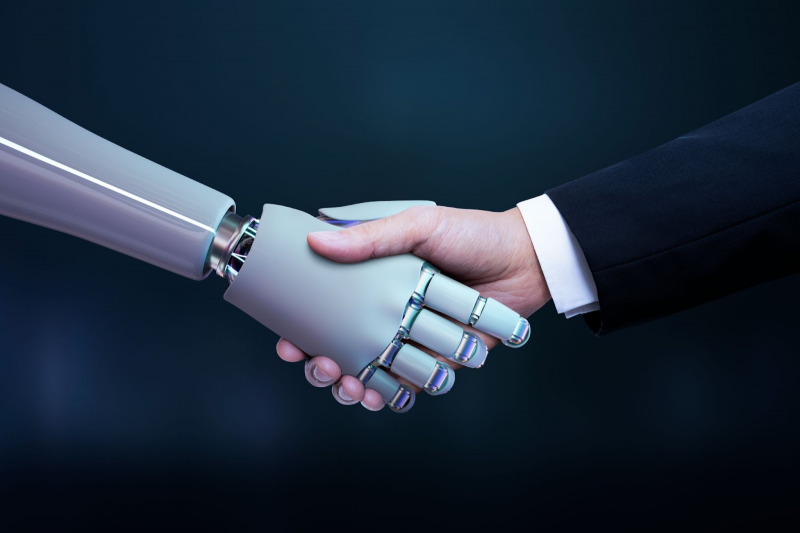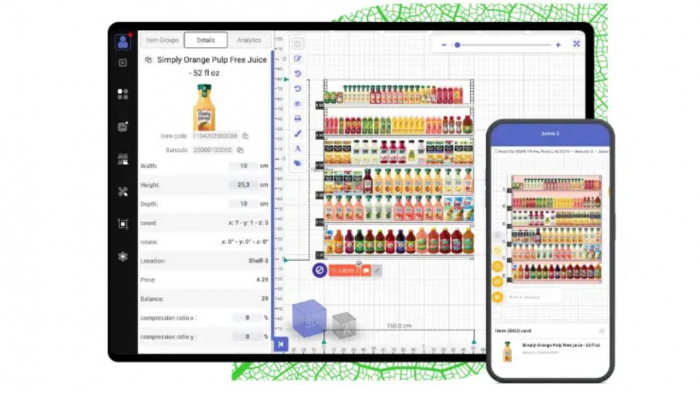In a rapidly changing sales market, companies are looking for ways to increase the effectiveness of their customer acquisition efforts. One of the most promising solutions is the use of artificial intelligence-based outbound sales crm. This software helps automate processes related to lead discovery and qualification, as well as customer engagement, improving the accuracy and speed of task completion.
(Immersive storefronts: AI+AR displays products and immediately generates personalized offers.)
What is AI SDR software for outbound sales?
AI SDR (Sales Development Representative) outbound sales software uses artificial intelligence to automate and optimize the processes of finding and qualifying leads, as well as interacting with them. This solution is focused on improving the performance of the sales department by streamlining tasks that traditionally require significant time and human resources.
Unlike traditional approaches, where sales professionals manually research, prioritize, and follow up with prospects, an AI SDR executes these steps quickly and accurately, improving the overall efficiency of the team.
In practice, the platform sources and enriches prospect data, then applies predictive scoring based on fit and intent signals to prioritize outreach. It launches multichannel cadences—email, LinkedIn, phone, and chat—auto-personalizing messages with relevant context, running A/B tests, and optimizing send times across time zones.
Conversation AI handles common replies, books meetings, and routes qualified opportunities to account executives, while tight CRM integrations keep records synchronized and eliminate duplicate work. Built-in guardrails manage unsubscribe logic, suppress current customers, and support GDPR/CCPA compliance. Real-time analytics surface conversion rates, sequence performance, and pipeline impact, enabling continuous improvement.
The result is faster response times, higher quality pipelines, and lower acquisition costs—freeing human reps to focus on high-value conversations and complex deal strategy rather than repetitive, error-prone tasks.
AI SDR helps companies:
- Automate lead search processes.
- Segment and qualify leads based on data.
- Organize initial contact with customers.
- Personalize marketing and sales offers.
- Improve sales team performance.
These tools can work in various areas, such as email, telephony, messengers, and other channels for connecting with potential customers.

(AI co-pilot for sales: automatic lead research, letters, and “next best action.”)
How does AI SDR software for outbound sales work?
AI SDR outbound sales software uses several key technologies and methods to effectively automate and optimize customer interactions.
1. Data collection and customer behavior analysis
AI SDR collects data from various sources, such as CRM systems, social networks, websites, and other public databases. This data includes information about customer behavior, their interests, purchase history, and even their online activity. Based on the collected data, the system analyzes each customer's behavior, identifies patterns, and evaluates their potential for making a purchase.
2. Lead segmentation and qualification
Once the data has been collected and analyzed, AI SDR uses machine learning algorithms to segment leads. This allows customers to be divided into several groups based on their needs, interests, and likelihood of making a purchase. The system assigns each lead a score (lead scoring), which helps the sales team focus on the most promising customers.
3. Automation of initial contact
Once leads are qualified and segmented, AI SDR outbound sales software can automatically initiate contact with potential customers. This can be done through email campaigns, phone calls, messenger messages, or even chatbots. The system uses personalized messages to address the right customer at the right time with maximum accuracy.
4. Response processing and analysis
Once a customer has responded to an offer or request, AI SDR continues to work with that lead, analyzing their responses and interactions. Based on the data obtained, the system can suggest the next step in the communication, such as sending additional information or redirecting the lead to a more qualified specialist.
5. Optimization of customer service
AI SDR also includes features for continuous process improvement. The system can learn from data obtained from previous contacts and, with each new interaction, become more accurate in predicting customer behavior and recommending next steps.
Advantages of using AI SDR software
Implementing AI SDR outbound sales software can bring significant benefits to companies by transforming prospecting from a manual, linear process into a scalable, data-driven engine. Instead of relying on ad-hoc lookups and generic outreach, teams can orchestrate always-on campaigns that find, qualify, and engage the right buyers at the right time—while maintaining CRM hygiene and compliance. Below are five high-impact advantages and what they look like in practice.
- Increased efficiency and productivityAI SDR dramatically accelerates lead discovery and qualification by automating enrichment, de-duplication, and fit/intent scoring. Reps receive prioritized queues, complete with talking points and context, rather than raw lists that require hours of prep. Automated cadences schedule first touches, follow-ups, and reminders across email, social, and phone, so no lead slips through the cracks. The result is more meetings booked per hour, shorter time-to-first-touch, and a higher ratio of selling time versus admin work—freeing humans to focus on discovery, demos, and closing.
- Improved data accuracy and qualityA core differentiator of AI SDR is rigorous data handling. The system normalizes firmographic and technographic fields, resolves entities to avoid duplicates, and flags stale or conflicting records. It fuses third-party intent, website engagement, and past interactions to predict conversion probabilities more reliably than manual heuristics. Continuous data quality checks keep CRM records consistent, while feedback loops from outcomes (replies, meetings, opportunities) recalibrate models. Over time, this produces cleaner pipelines, fewer bounced emails, and more precise forecasts.
- Personalized customer communicationModern buyers expect relevance. AI SDR tailors outreach using triggers such as role changes, funding events, technology stacks, or recent content consumption. Messages are auto-assembled with industry-specific value propositions, customer proof points, and problem statements that mirror each account’s context. Dynamic snippets adjust tone, length, and call-to-action by persona and stage. Multilingual templates and time-zone optimization further boost response rates. Personalization at scale turns cold outreach into timely, helpful conversations that earn attention and trust.
- Reduced operating costsAutomation compresses the cost of top-of-funnel work. Instead of expanding headcount to sustain coverage, teams scale outreach volume and quality with minimal marginal cost. AI handles list building, sequencing, and reply triage, reducing spend on external agencies and manual data services. Better targeting cuts wasted sends and lowers CAC, while meeting quality improves downstream win rates. In short, you grow pipeline without growing the payroll proportionally—and you redeploy budget to high-impact enablement and closing resources.
- System training and adaptationAI SDR improves with every interaction. Models learn which signals predict meetings for each ICP, which subject lines earn replies, and which sequences outperform in specific regions or quarters. Performance dashboards expose drift and seasonality, prompting automatic A/B tests and safe-guarded adjustments. Guardrails (opt-out handling, suppression lists, compliance policies) update in real time, ensuring responsible outreach at scale. The longer the system runs, the sharper its targeting and the more consistent its results.
Taken together, these benefits yield faster pipeline generation, higher conversion rates, and happier reps. Start small—one ICP, one sequence family, clear success metrics—and iterate. The compounding gains arrive quickly.

(The partnership between humans and algorithms: AI handles routine tasks, while salespeople build relationships and close deals.)
How to Choose AI SDR Software for Outbound Sales
Picking the right AI SDR platform is about aligning capabilities with your go-to-market, not just buying the shiniest tool. The best solutions automate lead discovery and qualification, personalize outreach across channels, and plug cleanly into your stack—so reps spend more time in high-value conversations and less on admin.
Start with goals and constraints
- Define outcomes (e.g., meetings booked, opportunities created, CAC targets).
- Clarify ICPs, geographies, languages, and compliance boundaries.
- Estimate monthly lead volume, channels you’ll use (email, LinkedIn, phone, SMS/WhatsApp).
- Map your stack (CRM, MAP, SEP, data providers) and must-have integrations.
Must-have capabilities
- Lead sourcing, enrichment, and de-duplication with firmographic/technographic fields.
- Predictive fit/intent scoring and dynamic prioritization queues.
- Multichannel sequencing with auto-personalization (role, industry, trigger events).
- AI reply handling for FAQs, meeting booking, and smart triage to humans.
- Experimentation (A/B tests, send-time optimization, subject/body testing).
- Real-time analytics: conversion by sequence, persona, segment, and rep.
Integration and data quality
- Native, bidirectional CRM sync (contacts, activities, opportunities) with field mapping.
- Support for custom objects and multi-currency, multi-timezone orgs.
- Data hygiene: normalization, dedupe rules, merge logic, and stale-record alerts.
- Webhooks/API depth for workflows with your data lake or reverse ETL.
Governance, compliance, and deliverability
- Built-in guardrails: suppression lists, frequency caps, buyer-opt-out handling.
- Compliance support (GDPR/CCPA/CASL) with audit logs and consent management.
- Email infrastructure: SPF/DKIM/DMARC, domain warm-up, inbox rotation, bounce control.
- Role-based access, SSO/SCIM, SOC 2/ISO 27001, and regional data residency options.
Usability and change management
- Intuitive sequence editor and template library; minimal clicks to launch.
- Quality controls: human-in-the-loop editing, tone/brand style guides, approval flows.
- Onboarding resources: playbooks, certification paths, and responsive support (SLA).
- Localization: multilingual generation and right-to-left UI where needed.
Pricing and scalability
- Transparent pricing (per seat vs. usage-based vs. hybrid) and overage policies.
- Clear limits on contacts, sends, mailboxes, and API calls.
- Performance at scale: concurrency, rate limits, and large-tenant reliability.
Prove value with a structured pilot (2–4 weeks)
- Select one ICP, one region, and 2–3 sequences as the test bed.
- Set baselines (reply rate, meeting rate, cost/meeting) and target lift.
- Run controlled A/B tests vs. your current process.
- Review weekly; iterate templates, segments, and send windows; document wins.
Red flags to avoid
- Black-box models with no edit controls or explainability.
- Weak CRM sync (one-way, delayed, or activity gaps).
- Poor deliverability hygiene or advice that skirts compliance.
- Vanity metrics without tie-back to pipeline and revenue.
Bottom line: Choose the tool that integrates cleanly, enforces good data and deliverability habits, and lets you personalize at scale with accountable metrics. That’s how AI SDR drives durable, compounding pipeline growth.
Post Comment
Be the first to post comment!

